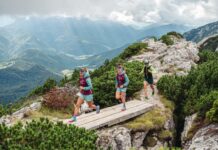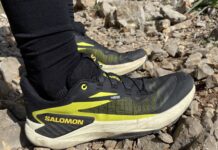
The Brooks Cascadia is arguably one of the first legitimate trail running shoes with specified construction ideally for trail running.
Debuting in 2005, most seasoned trail runners have been through a pair or two, and anyone can appreciate how this shoe remains largely unchanged from year to year.
A highly protective trail shoe, the Cascadia works well for runners who need additional support, as well as runners seeking a very durable rock plate for protection on technical trails.
The unfortunate reality of the Cascadia is that it remains a trail running shoe kept largely behind the times due to catering to a rabid fan base.
It could be argued either way, but a trail running shoe weighing in at over 12.5 ounces is hardly warranted in today’s market.
This is a shoe that mostly appeals to loyalists, seasoned veterans, and through hikers who love the consistency of the Cascadia lineage.
Brooks Cascadia 11 General Info

Brooks Cascadia 11 – Medial Side
The Brooks Cascadia sits as the single staple in Brooks’ trail running line with only the unheralded Adrenaline ASR and the Scott Jurek designed Pure Grit as competitors.
With Brooks really lacking a lightweight trail shoe option in their line, the Cascadia remains the protective and clunky monarch of their trail line.
When unboxing the Cascadia I experienced the same feeling with the Cascadia 8 and 9; this is a shoe that remains largely unchanged. If you’re a Cascadia person, you’ll love almost every iteration of this shoe.
Now, Cascadia faithfuls will say that I’ve completely erred here, but the Cascadia is a shoe that that changes approximately ten percent per year, and that only has to do with the upper.
We haven’t seen any major change in the midsole or outsole since the addition of BioMoGo in 2010.
Brooks Cascadia 11 Sole Unit

Brooks Cascadia 11 – Sole
The classic dual medial posting of the Cascadia is really the trademark of this shoe.
A bastion for any runner needing additional structure and support, and an absolute blessing for any runner at the end of an ultra when every anatomical aspect of the foot strike is collapsing inward, this dual medial posting offers protection in both the heel and forefoot of the shoe.
I can’t think of another shoe that so obviously and effectively protects for late stage pronation as the Cascadia 11.
If protection is what you seek, the Cascadia is also incredibly adept on the rockiest trails pioneering one of the best rock plates on the market.
Long a favorite of long distance hikers, the Cascadia is the type of shoe you put on and initially feel is too firm, kind of like your favorite hiking boot.
The more you wear the Cascadia, the more it feels like home, and this is a great option for 100 mile trail races or stage races.
The BioMoGo midsole used in the Cascadia is fairly stiff and this lack of flexibility lends itself well to those who struggle with metatarsalitis and plantar issues.
This material also is incredibly resilient, and the Cascadia 11 is a shoe you can expect to get far more than 500 miles in.
Brooks Cascadia 11 Upper Info

Brooks Cascadia 11 – Top
The Cascadia 11 struggles in this area, offering an overly padded (and heavy) heel cup which slips on steep hills.
While the upper is incredibly durably, it continues to feel overbuilt and more like an approach shoe than a trail running shoe.
The midfoot is supported by an integrated lacing system that is far overbuilt compared to any of its competitors. The welded on overlays feel the same; if you’re looking for shoe to through hike the PCT, the Cascadia 11 is your shoe.
However, from a running perspective, it feels like the Cascadia 11 could lose at least two ounces in upper material alone. Other testers complained about the narrow forefoot of the Cascadia 11, but I didn’t think this was an issue.
The Cascadia 9 seemed to max out the forefoot width while maintaining the same narrow last, and this version seemed to correct these oversights. Still, I wouldn’t consider the Cascadia 11 a well fitting shoe compared to its counterparts.
Brooks Cascadia 11 Conclusions
The Cascadia 11 will be the shoe on the feet of the 65-year old ultra-runner who passes you convincingly at 15 miles per hour at mile 70 of you 100 mile ultra marathon.
That doesn’t mean this is the right shoe for you. Just like that old man’s race ready shorts, the Cascadia is a useful relic, and if you decide to not explore past that, its fine.

Brooks Cascadia 11 – Lateral Side
You’re not getting passed because of your shoes; you’re getting passed because this race is that 65 year old man’s 35th hundred miler and he could give a flying frijole about shopping for the latest and greatest.
The Cascadia continues this heritage, and the upper on this completely disappoints.
I think that its time that Brooks looks past their own product line and develops a Cascadia that competes with modern trail running shoes which use modern materials to reduce weight, improve drainage, and allow a better fit.
If you’re a Cascadia faithful, my advice is to branch out and look at other brands.
We thank the nice people at Brooks for sending us a pair of Cascadia 11 to test. This did not influence the outcome of the review, written after running more than 50 miles in them.



























